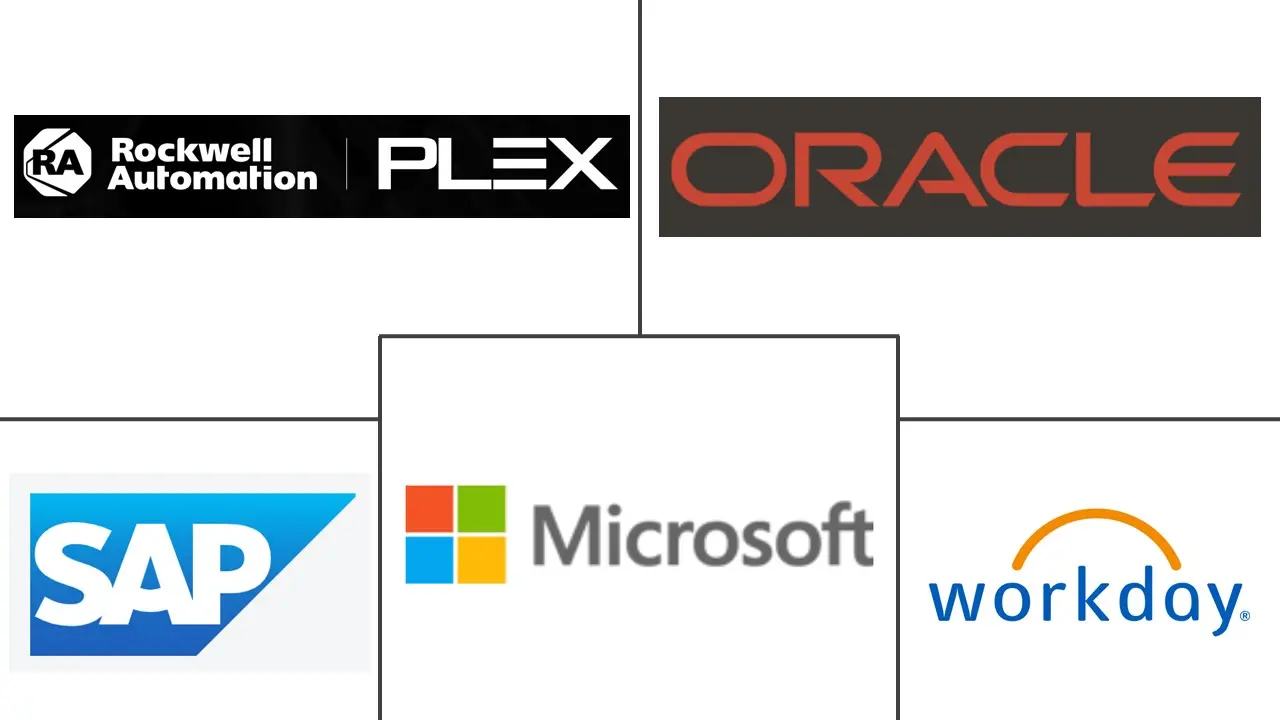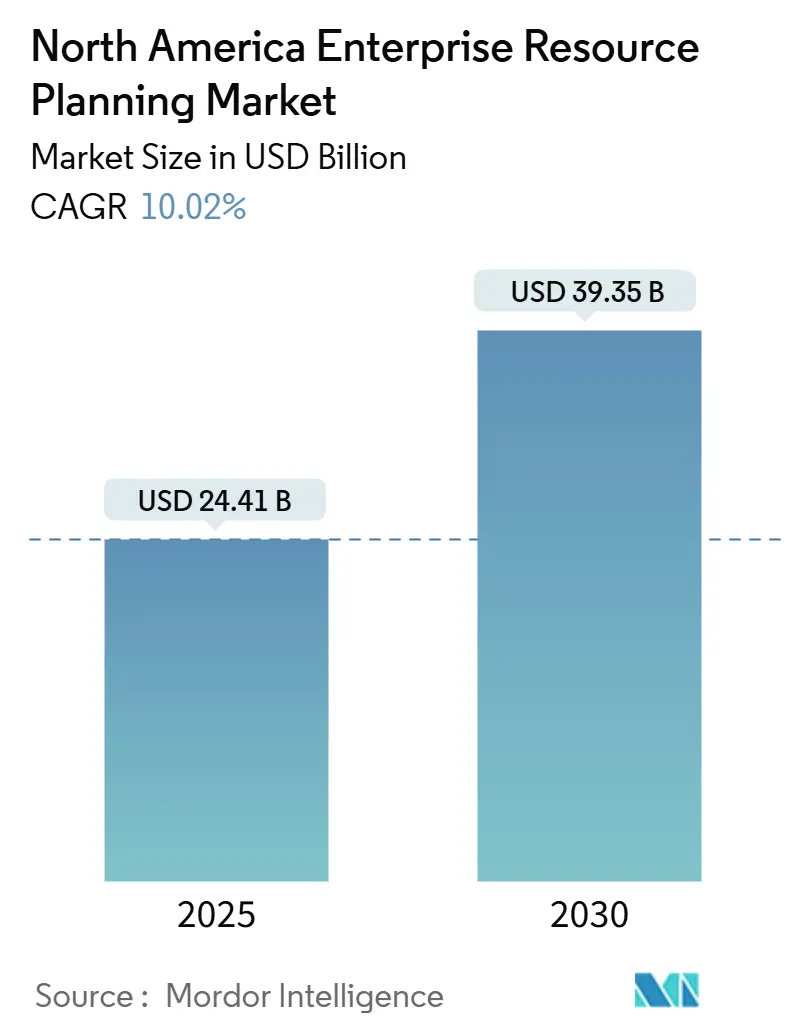
North America Enterprise Resource Planning Market Analysis by Mordor Intelligence
The North America enterprise resource planning market size stands at USD 24.41 billion in 2025 and is projected to reach USD 39.35 billion by 2030, reflecting a sturdy 10.0% CAGR. This expansion mirrors the region-wide migration from legacy on-premise suites to cloud-native platforms that give firms agility, real-time insights, and consumption-based cost structures. Heightened interest in AI-embedded analytics is reshaping implementation roadmaps, while mandatory environmental, social, and governance (ESG) disclosures push companies to modernize their financial consolidation processes. Oracle overtook SAP as the region’s largest ERP application supplier in 2024 with USD 8.7 billion in revenue and 6.63% North America enterprise resource planning market share, underscoring a sharpening rivalry among tier-1 vendors[1]Oracle Corporation, “Fiscal 2024 Annual Report,” oracle.com. Governments also catalyze uptake: the United States continues to modernize state and local systems, whereas Canada’s Digital Adoption Program subsidizes manufacturing ERP investments, and Mexico leverages USMCA digital-trade provisions to streamline cross-border data flows.
Key Report Takeaways
- By type, cloud-native suites led with 60.5% revenue share in 2024; social/collaborative ERP is forecast to grow at 11.4% CAGR through 2030.
- By business function, finance and accounting contributed 55.7% of the North America enterprise resource planning market size in 2024, while supply-chain and operations is advancing at a 10.8% CAGR.
- By deployment model, on-premise systems retained 67.8% share in 2024; cloud deployment is projected to expand at 11.9% CAGR.
- By organization size, large enterprises held 68.5% share of the North America enterprise resource planning market size in 2024; small and medium enterprises (SMEs) record the highest projected CAGR at 11.7%.
- By industry vertical, manufacturing commanded 24.7% revenue share in 2024; healthcare and life sciences is set to accelerate at a 10.5% CAGR through 2030.
- By country, the United States accounted for 41.8% revenue share in 2024, while Canada is forecast to grow at 11.1% CAGR between 2025 and 2030.
North America Enterprise Resource Planning Market Trends and Insights
Drivers Impact Analysis
| Driver | (~) % Impact on CAGR Forecast | Geographic Relevance | Impact Timeline |
|---|---|---|---|
| Rapid shift toward cloud-first ERP deployment models | +2.8% | North America-wide, with US leading adoption | Medium term (2-4 years) |
| Surge in AI-embedded analytics for real-time decision-making | +2.1% | Global, with early gains in US tech hubs and Canadian financial centers | Short term (≤ 2 years) |
| Two-tier ERP adoption to harmonize HQ and subsidiary operations | +1.6% | US and Canada multinational enterprises, Mexico emerging | Long term (≥ 4 years) |
| Rising SMB demand for affordable, modular SaaS suites | +1.9% | Canada and Mexico SME sectors, US mid-market expansion | Medium term (2-4 years) |
| ESG-linked reporting mandates accelerating system upgrades | +1.2% | US and Canada regulatory compliance, Mexico voluntary adoption | Long term (≥ 4 years) |
| Edge/IoT data integration for closed-loop operations | +1.4% | US manufacturing belt, Canadian resource sectors | Medium term (2-4 years) |
| Source: Mordor Intelligence | |||
Rapid Shift Toward Cloud-First ERP Deployment Models
Cloud adoption is now the baseline for new ERP rollouts as cost, scalability, and remote-work support eclipse entrenched on-premise preferences. Clark County, Washington, recorded 60% faster payroll runs and cut unapproved spending by 15% after moving to Workday. Hybrid architectures remain common because highly regulated firms keep sensitive data on-premise while extending edge or specialty functionality in public clouds. Security investments rose sharply in manufacturing corridors, and subscription-pricing lets finance teams reallocate capital budgets to strategic innovation rather than hardware refresh cycles. Alongside technology upgrades, chief information officers prioritize stakeholder training so cultural adoption matches architectural transformation.
Surge in AI-Embedded Analytics for Real-Time Decision-Making
Generative and predictive models are reshaping ERP from transaction recorders to intelligent orchestration engines. IBM and Oracle now co-develop autonomous agents that recommend policy-compliant actions across finance, supply chain, and HR workflows[2]IBM Corporation, “Oracle and IBM Partner on AI-Powered Workflow Agents,” ibm.com. NetSuite’s machine-learning accounts-payable module reduces manual invoice entry and speeds reconciliation, easing month-end close pressure. Manufacturers embed AI in plant-level modules for predictive maintenance, driving shorter unplanned downtime across the 95% of firms that already deploy smart-factory technologies. Healthcare providers leverage analytics to reconcile clinical and financial data, improving reimbursement accuracy and compliance reporting. All initiatives rely on robust governance because algorithmic bias or stale data can erode trust in automated decisions.
Two-Tier ERP Adoption to Harmonize HQ and Subsidiary Operations
Multinationals standardize core finance on tier-1 systems and equip subsidiaries with lighter SaaS suites that align cost to local scale, improving time-to-value for acquisitions and distant plants. The strategy supports industry-specific extensions—such as process manufacturing or field-service modules—without disrupting consolidated reporting. Seamless data exchange depends on modern integration platforms, and policy clarity ensures that headquarters maintains visibility while local teams retain operational freedom. USMCA digital-trade rules encourage friction-free data flows inside the region, reducing latency in consolidated close processes.
Rising SMB Demand for Affordable, Modular SaaS Suites
SMEs previously sidelined by expensive, monolithic platforms now buy modular ERP bundles that scale by user count and function. Canada’s national Digital Adoption Program reimburses up to CAD 100,000 (USD 73,000) in interest-free loans for manufacturing digitization, directly lowering upfront barriers. Academic studies confirm that top-management commitment, user participation, and methodical change management drive successful SME deployments. Vendors respond with industry templates and pre-configured charts of accounts that cut implementation cycles by weeks. As a result, the North America enterprise resource planning market sees SME cloud subscriptions outpace large-enterprise seat growth year after year.
Restraints Impact Analysis
| Restraint | (~) % Impact on CAGR Forecast | Geographic Relevance | Impact Timeline |
|---|---|---|---|
| Up-front and life-cycle costs of implementation and change-management | -1.8% | North America-wide, particularly affecting SME adoption rates | Short term (≤ 2 years) |
| Cyber-security and data-sovereignty concerns in multitenant clouds | -1.2% | US and Canada enterprise segments, Mexico emerging awareness | Medium term (2-4 years) |
| Shortage of North America-based ERP talent and project bandwidth | -0.9% | US tech hubs and Canadian urban centers, Mexico developing capacity | Long term (≥ 4 years) |
| Vendor lock-in risk amid shrinking on-premise support windows | -0.7% | Legacy system enterprises across North America | Medium term (2-4 years) |
| Source: Mordor Intelligence | |||
Up-Front and Life-Cycle Costs of Implementation and Change-Management
Comprehensive ERP projects absorb expenses that extend well beyond license or subscription fees. Data migration, business-process re-engineering, and staff training frequently double original budgets for hospitals and public agencies, as seen in multi-year modernizations at Baptist Health. SMEs rely on external consultants because they lack dedicated IT capacity, but scarce talent drives day-rates higher and stretches timelines. Cloud delivery softens capital expenditure yet does not eliminate the cultural shifts required for process standardization. Without robust change-leadership structures, expensive platforms risk under-utilization and diminished ROI.
Cyber-Security and Data-Sovereignty Concerns in Multitenant Clouds
High-profile breaches keep security top-of-mind as regulated sectors weigh multitenant efficiency against possible lateral-movement attacks. Financial-services regulators in both the United States and Canada push firms to demonstrate encryption, segregation, and audit-log rigour. Some institutions store customer PII in private clouds and link to SaaS ERP through tokenized proxies. The Cloud Security Alliance advises detailed shared-responsibility matrices to clarify boundaries between vendor and customer obligations. Firms also reconcile national localization mandates with USMCA commitments that champion borderless data flows, creating a nuanced compliance landscape.
Segment Analysis
By Type: Social Platforms Drive Workforce Engagement
Cloud-native suites accounted for 60.5% revenue in 2024, ensuring the North America enterprise resource planning market retains a strong baseline of broad-function platforms. Social/collaborative ERP, however, will grow fastest at 11.4% CAGR through 2030 as corporations seek consumer-grade user experiences. Knowledge workers adopt activity feeds, shared dashboards, and real-time chat inside finance and supply-chain transactions, lifting system usage rates and shortening approval cycles. Integrated mobile apps deliver the same capabilities at job sites or customer locations, reinforcing always-connected workflows. Vendor roadmaps increasingly bundle social elements by default rather than as optional modules, underscoring their strategic value. Over time, artificial-intelligence assistants embedded in these channels will recommend actions or flag exceptions, deepening the linkage between engagement and operational efficiency.
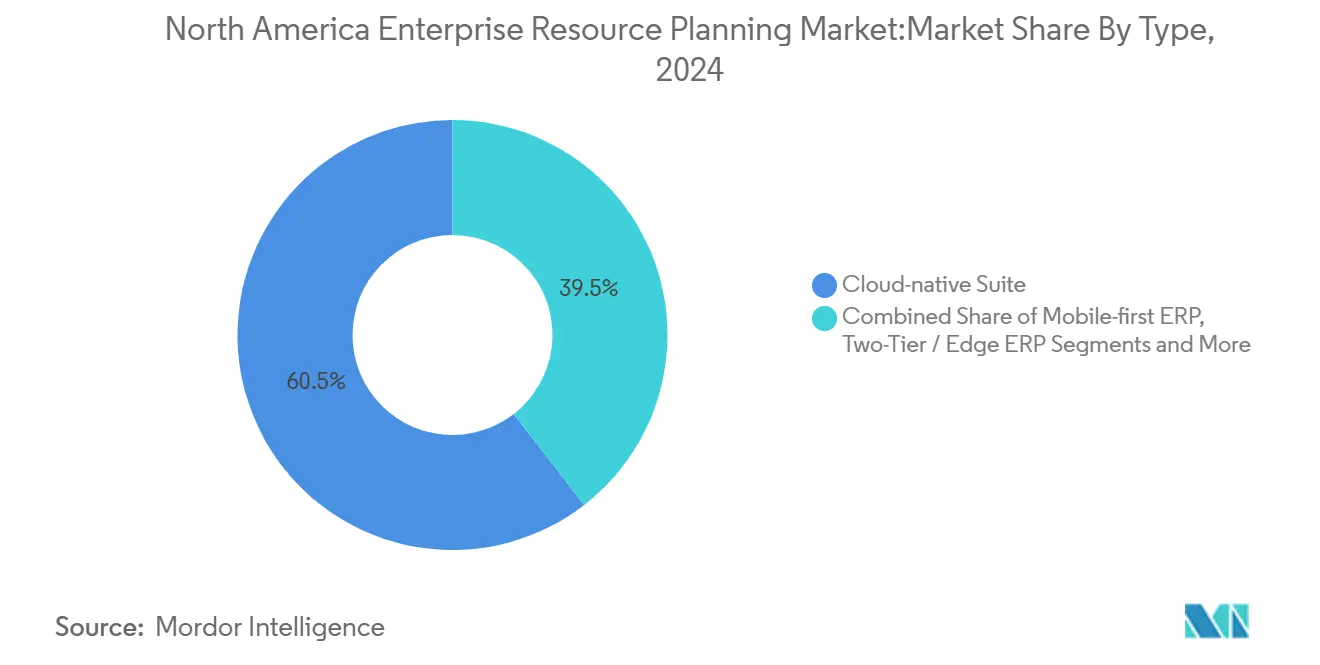
Note: Segment shares of all individual segments available upon report purchase
By Business Function: Supply-Chain Optimization Accelerates Growth
Finance and accounting maintained 55.7% of the North America enterprise resource planning market size in 2024, reflecting mandatory reporting and audit requirements. Nonetheless, supply-chain and operations modules will expand at a 10.8% CAGR. Edge computing and the Internet of Things feed real-time shop-floor data into planning algorithms, improving material availability and lowering working capital. Predictive shipment ETAs support omnichannel commitments, while automated quality-checks cut return rates. Human-capital modules meanwhile gain priority as manufacturers confront labour shortages and rising voluntary turnover. Customer-commerce add-ons connect order capture to inventory, letting firms promise exact delivery windows that boost conversion rates. Finance still acts as the system-of-record, but operational datasets increasingly drive profit-and-loss outcomes.
By Deployment Model: Cloud Migration Reshapes Infrastructure
On-premise platforms held 67.8% share in 2024 because many regulated organizations have yet to re-platform core ledgers. However, cloud deployments are poised for 11.9% CAGR as subscription cost models, automatic upgrades, and AI feature releases outweigh migration headaches. Hybrid coexistence lets firms phase workloads in logical waves, maintaining local database instances for high-risk data while shifting HR, procurement, or analytics into multitenant SaaS. Migration success hinges on data-quality initiatives and modern security architectures such as zero-trust and continuous monitoring. In turn, cloud vendors cultivate ecosystem marketplaces so partners distribute niche industry plug-ins that customers can switch on without lengthy project cycles. Enterprises that adopt these ecosystems early set themselves up for faster innovation consumption over the forecast horizon.
By Organization Size: SME Growth Outpaces Enterprise Adoption
Large enterprises owned 68.5% of the North America enterprise resource planning market size in 2024 through multi-entity, multi-currency implementations. Yet SMEs will expand usage at 11.7% CAGR because modular SaaS suites remove servers, shorten projects, and fit cash-flow realities. Government grants, such as Canada’s CAD 15,000 (USD 11,000) advisory vouchers, further ease entry barriers. Vendors cultivate quick-start templates with industry taxonomies already configured, reducing consulting hours to a fraction of prior norms. Still, SMEs struggle with organizational change when moving from spreadsheets, emphasizing the need for executive sponsorship and staged rollouts that respect resource constraints. Flexible licence tiers allow these firms to add warehouse, ecommerce, or service-management plug-ins when scale justifies incremental spend.
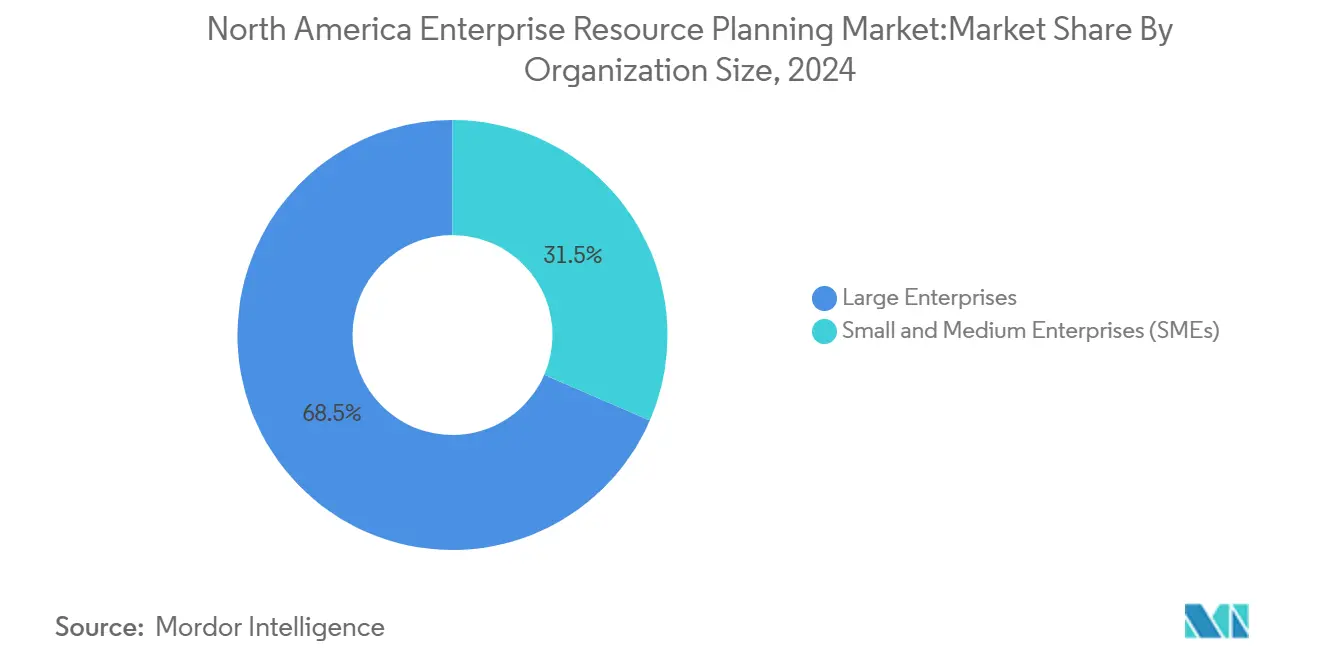
By Industry Vertical: Healthcare Modernization Drives Acceleration
Manufacturing kept its leadership with 24.7% revenue share in 2024, but healthcare and life sciences will climb fastest at 10.5% CAGR as providers integrate clinical and financial data on secure, cloud-ready platforms. U.S. hospital systems deploy ERP to rationalize supply chains after pandemic-era stockouts and to comply with price-transparency regulation. Pharmaceutical producers need validated batch records, while medical-device firms track Unique Device Identifiers throughout the chain. In parallel, retailers expand omnichannel programs, converging point-of-sale and back-office systems so they can reconcile margins per order line. Banking, insurance, and public-sector entities modernize ledgers to support faster close cycles and digital-service expectations from constituents.
Geography Analysis
The United States captured 41.8% of 2024 revenue, reflecting its broad enterprise base, mature cloud infrastructure, and vigorous public-sector digital-transformation agenda. State and local governments migrate to SaaS suites: Missouri implemented Oracle, Illinois modernized with SAP, and Washington selected Workday to replace aging mainframes. Municipal projects echo the trend; Los Angeles rolled out CGI Advantage, eliminating 130 customizations and integrating directly with AWS and Salesforce back-office stacks. U.S. healthcare systems continue multi-year Oracle Cloud transitions that merge supply, finance, and HR silos into a single data backbone.
Canada represents the fastest-growing geography at 11.1% CAGR to 2030, propelled by the federal Digital Adoption Program, a national Digital Government Strategy, and a projected 9% digital-economy CAGR. Policy frameworks encourage cross-border data flows while preserving privacy rights, allowing cloud ERP vendors to run multitenant data centers on Canadian soil without constraining analytics use cases[3]U.S. Department of Commerce, “Canada Country Commercial Guide – Digital Services,” commerce.gov. Montréal’s thriving fintech cluster attracts venture capital that extends innovation to ERP integrations, particularly around payment reconciliation and subscription revenue accounting. Harmonized intellectual-property rules afford Canadian software publishers seamless entry to U.S. markets, enlarging the addressable customer pool for domestic vendors.
Mexico emerges as an opportunity corridor as near-shoring manufacturing investments relocate supply chains closer to North American end-markets. USMCA guarantees tariff-free digital trade, creating a legal bedrock for centralized ERP deployments that span borders. However, sector-specific localization directives in banking and public finance can force hybrid architectures. Mexican factories use modular SaaS suites to comply with electronic-invoicing laws and to track import-export documentation in real time. Talent-development programs in Monterrey and Guadalajara aim to boost local consulting capacity so enterprises need not rely solely on U.S. integrators.
Competitive Landscape
The North America enterprise resource planning market shows moderate concentration as tier-1 incumbents battle on AI capability, vertical depth, and ecosystem breadth. Oracle generated USD 8.7 billion in regional ERP revenue during 2024, edging past SAP’s USD 8.6 billion, thanks to USD 87,700 average annual spend per customer versus SAP’s USD 61,429. SAP nonetheless grows at a brisk pace after embedding sustainability control-tower features for automated ESG reporting. Microsoft Dynamics and Workday pursue industry playbooks—retail, healthcare, and public sector—while Infor concentrates on asset-intensive verticals.
Strategic alliances multiply as platforms seek complementary strengths. IBM’s co-development pact with Oracle adds generative-AI workflow agents that cut manual approval loops, and Big Blue’s recent purchase of Applications Software Technology LLC bolsters its public-sector Oracle practice. NetSuite deepens channel coverage through SuiteSuccess industry bundles that offer pre-configured KPIs. SAP acquired WalkMe to address user-adoption friction by layering contextual guidance on top of its Fiori interface.
Private-equity capital intensifies mid-market consolidation. Vista Equity Partners bought Acumatica for USD 2 billion, betting on an AI-rich roadmap and distribution via independent software vendors. Aptean is folding JobRouter and Logility into its stack to blend intelligent process automation with tactical supply-chain planning. Regional VARs also merge: SEIDOR purchased B1 Solutions to scale SAP Business One services for SMEs. This roll-up trend unlocks cross-sell synergies yet raises post-merger integration risks, including partner-channel overlap.
North America Enterprise Resource Planning Industry Leaders
-
SAP SE
-
Oracle Corporation
-
Microsoft Corporation
-
Workday, Inc.
-
Plex Systems Inc. (Rockwell Automation Inc.)
- *Disclaimer: Major Players sorted in no particular order
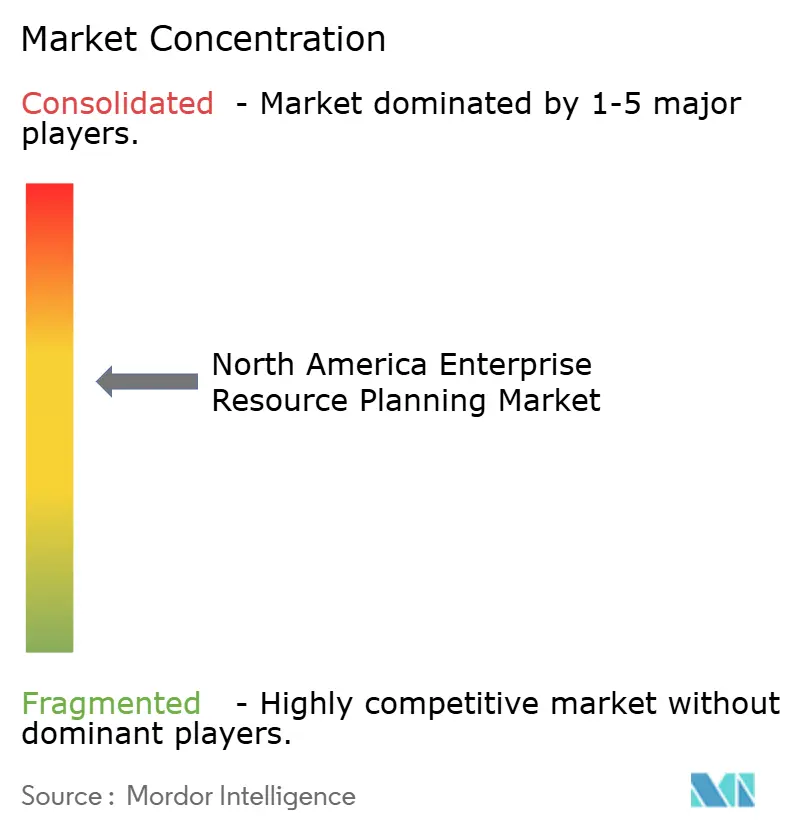
Recent Industry Developments
- May 2025: Vista Equity Partners completed the acquisition of Acumatica for about USD 2 billion, positioning the cloud ERP vendor for accelerated AI development and partner-ecosystem expansion.
- May 2025: IBM and Oracle announced a partnership to embed AI agents into enterprise workflow automation across finance, supply chain, and HR suites.
- May 2025: Salesforce disclosed an agreement to acquire Informatica, enhancing data-integration and analytics capabilities that complement ERP ecosystems.
- January 2025: IBM finalized the acquisition of Applications Software Technology LLC, expanding Oracle Cloud consulting capacity in North America and Europe.
North America Enterprise Resource Planning Market Report Scope
Enterprise Resource Planning software can be defined, in simple terms, as a tool that helps us plan all the resources, both human and material, in any organization effectively and efficiently. Still, in reality, they are capable of managing financials, supply chains, manufacturing, operations, reporting, and human resources. They also help in decision-making through real-time data analytics and provide a consolidated view of key business metrics from operations across the business.
The North American ERP market is segmented by deployment (on-premises, cloud, hybrid), size of business (SMBs, Large enterprises), type (mobile, cloud, social, two-tier), application (retail, manufacturing, BFSI, government, telecom, defense, education & research, transport & logistics, other end-user industries), and by Country (United States, Canada, Mexico). The report offers market forecasts and size in value (USD) for all the above segments.
| Cloud-native Suite |
| Mobile-first ERP |
| Social / Collaborative ERP |
| Two-Tier / Edge ERP |
| Finance and Accounting |
| Supply-Chain and Operations |
| Human Capital Management |
| Customer Relationship and Commerce |
| Manufacturing Execution and Quality |
| On-premise |
| Cloud |
| Large Enterprises |
| Small and Medium Enterprises (SMEs) |
| Manufacturing |
| Retail and E-commerce |
| BFSI |
| Government and Public Sector |
| IT and Telecom |
| Healthcare and Life Sciences |
| Others |
| United States |
| Canada |
| Mexico |
| By Type | Cloud-native Suite |
| Mobile-first ERP | |
| Social / Collaborative ERP | |
| Two-Tier / Edge ERP | |
| By Business Function | Finance and Accounting |
| Supply-Chain and Operations | |
| Human Capital Management | |
| Customer Relationship and Commerce | |
| Manufacturing Execution and Quality | |
| By Deployment Model | On-premise |
| Cloud | |
| By Organization Size | Large Enterprises |
| Small and Medium Enterprises (SMEs) | |
| By Industry Vertical | Manufacturing |
| Retail and E-commerce | |
| BFSI | |
| Government and Public Sector | |
| IT and Telecom | |
| Healthcare and Life Sciences | |
| Others | |
| By Country | United States |
| Canada | |
| Mexico |
Key Questions Answered in the Report
What is the current size of the North America enterprise resource planning market?
The market is valued at USD 24.41 billion in 2025 and is forecast to grow to USD 39.35 billion by 2030.
Which deployment model is growing fastest in the North America enterprise resource planning market?
Cloud deployments are expanding at an 11.9% CAGR as firms migrate from on-premise infrastructure to subscription-based SaaS.
Which industry will adopt ERP systems most rapidly through 2030?
Healthcare and life sciences show the highest growth, with a 10.5% CAGR driven by regulatory compliance and operational efficiency needs.
How are SMEs influencing the North America enterprise resource planning market?
SMEs are driving an 11.7% CAGR thanks to modular SaaS suites and government incentives that lower upfront costs.
Which vendor currently leads the North America enterprise resource planning market?
Oracle overtook SAP in 2024 with USD 8.7 billion in regional ERP revenue and 6.63% share.
What major risk could dampen ERP adoption in North America?
Cyber-security and data-sovereignty concerns remain significant, especially for regulated industries contemplating multitenant cloud environments.
Page last updated on:
